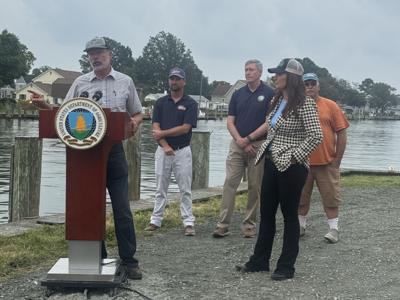TILGHMAN ISLAND, Md. - U.S. Secretary of Agriculture Brooke Rollins visited Maryland’s Eastern Shore on Wednesday to announce $6 million in federal grant funding aimed at tackling invasive catfish in the Chesapeake Bay while boosting local seafood processors.
The money will be distributed through USDA’s Meat and Poultry Processing Expansion Program and is expected to help businesses build or upgrade processing facilities, invest in equipment, and increase capacity for wild-caught catfish- specifically the invasive blue catfish, which has severely disrupted the Bay’s ecosystem.
“This is about more than just a funding announcement,” Rollins said at a press conference outside Tilghman Island Seafood. “It’s a win for our rural communities, a win for our fishermen, and a win for families in need.”
The announcement also included details of a separate, one-year pilot program. In partnership with the Maryland Department of Agriculture, USDA will purchase up to $2 million worth of Chesapeake Bay blue catfish through Section 32 to be distributed through food banks across the country. Officials say it’s part of a broader effort to convert a regional ecological challenge into a national nutritional solution.
Representative Andy Harris, who joined Rollins for a tour of the seafood facility before the announcement, praised the move as a “big win” for coastal economies.
“The $6 million available through the program is a major investment in Maryland’s watermen and seafood producers,” Harris said. “It’s also another way the Trump administration is supporting sustainable seafood and American jobs.”
Nick Hargrove, who operates Tilghman Island Seafood, said the new funding could be a game-changer for small processors like his.
“Without processing facilities, watermen don’t have anywhere to take their catch,” Hargrove said. “If we can go from handling 20,000 pounds a day to 40,000, that means more fishermen working and more catfish off the water.”
The invasive blue catfish has spread rapidly throughout the Bay in recent years, outcompeting native species and threatening fisheries. By creating market demand for the species, officials hope to curb its population while supporting local economies and food security efforts.
Grants will range from $250,000 to $1 million, and recipients must match 50 percent of the total project cost. Applications are due by Oct. 6.


